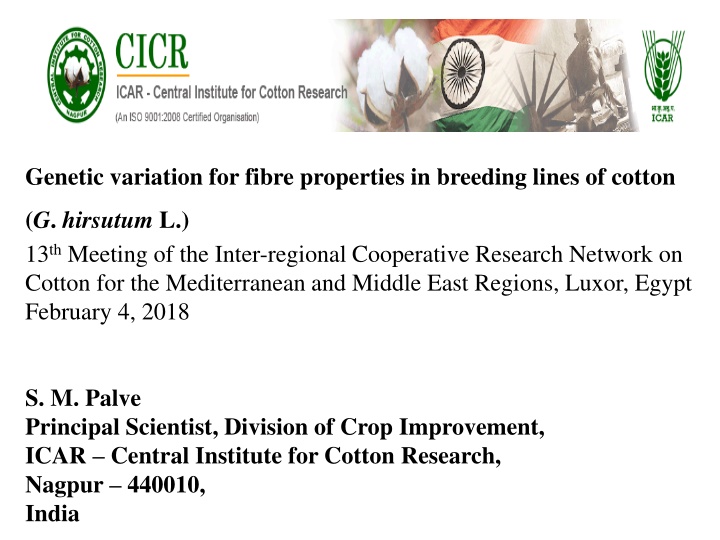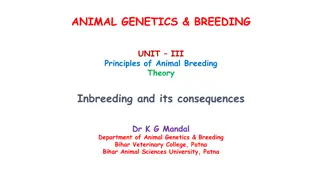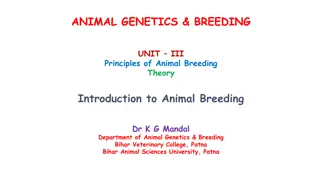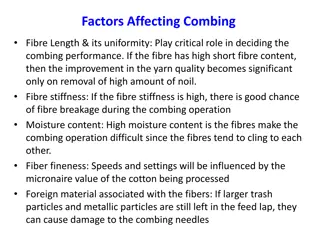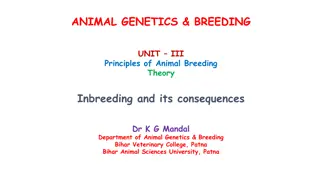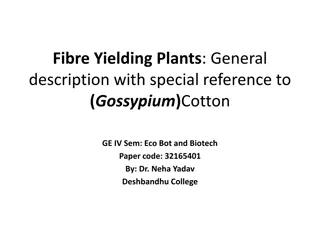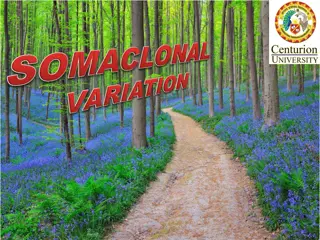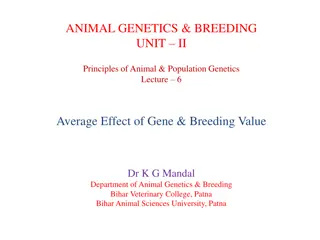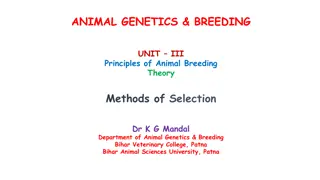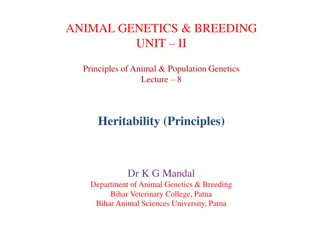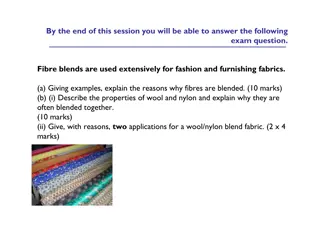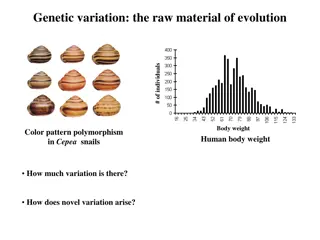Genetic variation for fibre properties in breeding lines of cotton
This study explores the genetic diversity in cotton breeding lines and its impact on fibre properties. The research was presented at the 13th Meeting of the Inter-regional Cooperative Research Network on Cotton for the Mediterranean and Middle East Regions in Luxor, Egypt.
Download Presentation

Please find below an Image/Link to download the presentation.
The content on the website is provided AS IS for your information and personal use only. It may not be sold, licensed, or shared on other websites without obtaining consent from the author.If you encounter any issues during the download, it is possible that the publisher has removed the file from their server.
You are allowed to download the files provided on this website for personal or commercial use, subject to the condition that they are used lawfully. All files are the property of their respective owners.
The content on the website is provided AS IS for your information and personal use only. It may not be sold, licensed, or shared on other websites without obtaining consent from the author.
E N D
Presentation Transcript
Genetic variation for fibre properties in breeding lines of cotton (G. hirsutum L.) 13th Meeting of the Inter-regional Cooperative Research Network on Cotton for the Mediterranean and Middle East Regions, Luxor, Egypt February 4, 2018 S. M. Palve Principal Scientist, Division of Crop Improvement, ICAR Central Institute for Cotton Research, Nagpur 440010, India
Figure : Zonal Map of India showing distribution and zones Source: CICR, nagpur
Introduction Cotton is grown in a wide range of ecosystems under varying temperatures and water regimes Of the four cultivated species, G. hirsutum occupies largest area under cultivation. India is the leading country in terms of area under cotton cultivation and raw cotton production in the world. Cotton is grown on 105 lakh hectares with the production of 351 lakh bales of 170 kg with a productivity of 568 kg lint/ha during 2016- 17. Cotton production in rainfed areas erratic rain distribution, water stress is common, impacting on productivity and fibre quality
Cotton Growing Zones in India Zones North Zone Central Zone South Zone States Punjab, Haryana, Rajasthan Maharashtra, Gujarat, Orissa Madhya Pradesh, Andhra Pradesh, Karnataka, Tamil Nadu Area 11.96 lakh ha 68.05 lakh hectares 23.13 lakh hectares Production 40.40 lakh bales 195.35 lakh bales 84.20 lakh bales Productivity 668 kg/ ha 512 kg/ ha 691 kg/ ha Av. India 568; World kg/ha - 788 Conditions 100% irrigated Irrigated and rainfed Irrigated and rainfed Nature of Genotype Hybrids and varieties Hybrids and varieties Hybrids and varieties G. hirsutum, G. arboreum G. hirsutum, G. arboreum, Intra hirsutum, G. herbaceum G. hirsutum, G. arboreum, G. herbaceum, G. barbadense Interspp. Tetrapl. Hy. (HB) Species Insect/ Pest Heliothis, Whitefly, Jassids, Pink bollworm, Mealy bug Heliothis, Aphids, Pink bollworm, Mealy bug Whitefly, Jassids, Heliothis, Whitefly, Jassids, Aphids, Pink bollworm Diseases Leaf curl virus, Wilt Wilt Wilt, Foliar disease Time of Sowing April- June June-July July- August (Source:CottonAdvisory Board as on 24.10.2016)
Background Cotton breeders faces the task of developing varieties/hybrids that perform well in the farmer s field, at the gin and in the textile processing Evaluation of fibre quality parameters of cotton genotypes with strong support from ICAR-Central Institute for Research on Cotton Technology(ICAR-CIRCOT), Mumbai Fiber samples were taken from genotype and were evaluated using HVI classification. Parameters included micronaire, fiber length, length uniformity index , strength and elongation.
Materials and Methods Experimental materials statistical design of experiment Name of the Experiment Genotypes Statistical Design 27 CRBD Genetic variation for fibre properties in breeding lines of cotton (G. hirsutum) Observations on yield attributing traits and fibre properties
In order to improve simultaneously seed cotton yield and fibre quality of G. hirsutum cotton, through conventional breeding, efforts were made for developing improved breeding lines with greater length, strength and uniformity at ICAR Central Institute for Cotton Research, Nagpur, India. Twenty five breeding lines along with two check varietiesSuraj and NH 615 were evaluated in randomized block design for fibre properties during 2016-17. Fibre properties were evaluated (Ginning Training Centre, ICAR- CIRCOT, Nagpur) using High Volume Instrument (HVI).
Results and Discussion ANOVA showed that genotypes differed significantly from each other for plant height, boll weight, UHML, UI, BS and Elongation percentage Plant height ranged from 91 cm (CNH 09-52) to 116 cm (CNH 09-70). Number of sympodial branches varied from 1855 (CNH 09-54) to 24.1 (CNH 09-78). Heighest boll weight of 4.9 g was recorded by CNH 09-51 and CNH 09-69.
Table 1. Mean values of seed cotton yield and yield attributing traits Genotype Plant Height(cm) 100.8 92.0 100.6 96.0 91.1 93.4 91.3 96.8 97.2 95.7 99.3 103.5 103.1 116.1 No. of Mono. 1.5 1.3 1.2 1.3 2.5 0.9 2.2 1.8 1.6 1.0 1.3 1.5 1.6 1.3 No. of Symp. 20.7 20.4 18.7 20.8 20.6 18.5 22.2 20.7 19.4 19.5 21.6 21.1 22.8 22.1 Boll No. Boll wt. SCY/ha (kg) (g) CNH09-21 CNH09-33 CNH09-45 CNH09-51 CNH09-52 CNH09-54 CNH09-55 CNH09-56 CNH09-57 CNH09-58 CNH09-59 CNH09-67 CNH09-69 CNH09-70 25.4 28.2 22.8 22.1 22.3 19.9 23.6 21.4 19.8 24.2 25.0 118.5 25.6 23.2 4.4 3.7 4.3 4.9 4.2 3.8 3.8 3.9 4.4 4.7 3.8 4.5 4.9 4.4 2192 2167 1504 1338 1604 1705 1681 1070 899 1855 2006 2400 2508 1446
Genotype Plant Height(cm) 104.7 105.1 115.4 98.5 105.6 102.7 108.9 85.1 95.8 95.0 88.0 99.3 5.4 15.8 No. of Mono. 1.1 1.2 0.4 1.0 1.3 1.9 0.6 0.6 1.8 1.3 1.8 1.4 0.4 No. of Symp. 22.1 22.2 22.9 19.8 21.3 21.7 24.1 19.7 22.1 20.8 17.5 20.9 1.4 Boll No. 25.2 22.4 23.4 21.7 19.5 24.5 21.6 19.8 26.1 22.9 22.7 26.9 18.9 Boll wt. (g) 4.1 4.0 4.2 3.5 4.6 4.1 4.5 3.9 4.2 4.6 3.4 4.2 0.2 0.7 SCY/ha (kg) CNH09-71 CNH09-72 CNH09-73 CNH09-75 CNH09-76 CNH09-77 CNH09-78 CNH09-79 CNH09-80 SURAJ NH 615 Mean SE LSD 5 % 2192 1103 3074 1833 2030 1966 2431 2609 2368 1838 1558 1895 411.2 - - - -
Breeding lines CNH 09-73, CNH 09-78 and CNH 09-79 had lowest monopodial branches amongst breeding lines evaluated These lines suitable for high density planting system (HDPS) having both yield fibre properties at par with the check variety Suraj
Table 2. Mean values of fibre properties Genotype UHML (mm) CNH09-21 CNH09-33 CNH09-45 CNH09-51 CNH09-52 CNH09-54 CNH09-55 CNH09-56 CNH09-57 CNH09-58 CNH09-59 CNH09-67 CNH09-69 CNH09-70 UI (%) Mic. BS (g/tex) EL. (%) 29.5 30.9 30.5 28.1 30.4 28.8 29 30.1 29.1 31.2 27.7 27.7 28.6 27.7 82.5 83 83 81.5 83 81.5 82 82.5 82 83 81.5 81 82 81.5 3.6 3.7 3.6 4.7 4.2 4.4 3.7 3.6 3.8 4 4.4 3.5 3.7 3.4 30.8 29.3 35.8 30.2 27.7 29.8 30.3 31.4 30.6 33.5 29.6 31.2 30.8 31.5 5.9 5.7 6.1 6 6.1 6.2 5.9 6.5 6.5 6.5 6.0 6.1 6.1 6.1
Genotype UHML (mm) UI (%) Mic. BS (g/tex) 32.8 34.6 33.4 33.1 31.3 34.7 33.1 32.9 32.9 31.5 28.5 31.6 1.3 3.7 EL. (%) CNH09-71 CNH09-72 CNH09-73 CNH09-75 CNH09-76 CNH09-77 CNH09-78 CNH09-79 CNH09-80 SURAJ NH 615 Mean SE 28.6 29.4 28.9 31.1 29.4 30.1 29.1 30.4 29 32.1 27.0 29.4 0.7 1.9 82 82 82 83 82 82.5 82 82.5 82 83.5 80.5 82.2 0.4 1.2 3.5 3.1 3.7 3.7 3.5 3.3 3.2 3.5 3.7 3.9 4.2 3.7 0.3 - 6.1 6.3 6.4 6.5 6.0 6.2 6.0 6.1 6.2 6.3 5.6 6.1 0.1 0.4 LSD 5 %
Staple Length Categories of Indian Cottons Based on UHML Category Short Medium Medium Long Long Extra long Range of UHML 20 mm and below 20.5 24.5 25.0 27.0 27.5 32.0 32.5 mm and above Ratings of Cotton on the basis of Length Uniformity Category Poor Fair Average Good Excellent UI Below 76 76 to 78 79 to 83 83 to 85 Above 85
Classification of Cottons According to Micronaire Value Category Range of Micronaire Value Very fine Fine Average Coarse Very coarse Below 3.0 3.0 to 3.9 4.0 to 4.9 5.0 to 5.9 6.0 and above Ratings of cotton based on tenacity at 3.2 mm gauge length (HVI mode) Category Range of Bundle tenacity values in g/tex 20.0 & below 20.1 25.0 25.1 29.0 29.1 32.5 Above 32.5 Very weak Weak Average Good Very good
Table 3. Mean seed cotton yield (kg/ha) and fibre properties Genotype SCY/ha (kg) 2192 2167 1504 1338 1604 1705 1681 1070 899 1855 2006 2400 2508 UHML (mm) 29.5 30.9 30.5 28.1 30.4 28.8 29 30.1 29.05 31.2 27.7 27.7 28.6 UI (%) 82.5 83 83 81.5 83 81.5 82 82.5 82 83 81.5 81 82 Mic. BS EL. (%) 5.9 5.7 6.1 6 6.1 6.2 5.9 6.5 6.5 6.5 6.0 6.1 6.1 (g/tex) 30.8 29.3 35.8 30.2 27.7 29.8 30.3 31.4 30.6 33.5 29.6 31.2 30.8 CNH09-21 CNH09-33 CNH09-45 CNH09-51 CNH09-52 CNH09-54 CNH09-55 CNH09-56 CNH09-57 CNH09-58 CNH09-59 CNH09-67 CNH09-69 3.6 3.7 3.6 4.7 4.2 4.4 3.7 3.6 3.8 4 4.4 3.5 3.7
Genotype SCY/ha (kg) 1446 2192 1103 3074 1833 2030 1966 2431 2609 2368 1838 1558 1895.0 411.2 UHML (mm) 27.7 28.6 29.4 28.9 31.1 29.4 30.1 29.1 30.4 29 32.1 27.0 29.4 0.7 1.9 UI (%) 81.5 82 82 82 83 82 82.5 82 82.5 82 83.5 80.5 82.2 0.4 1.2 Mic. BS (g/tex) 31.5 32.8 34.6 33.4 33.1 31.3 34.7 33.1 32.9 32.9 31.5 28.5 31.6 1.3 3.7 EL. (%) CNH09-70 CNH09-71 CNH09-72 CNH09-73 CNH09-75 CNH09-76 CNH09-77 CNH09-78 CNH09-79 CNH09-80 SURAJ NH 615 Mean SE LSD 5 % 3.4 3.5 3.1 3.7 3.7 3.5 3.3 3.2 3.5 3.7 3.9 4.2 3.7 0.3 - 6.1 6.1 6.3 6.4 6.5 6.0 6.2 6.0 6.1 6.2 6.3 5.6 6.1 0.1 0.4 -
Among the best performing breeding lines, CNH 09-69, CNH 09- 73, CNH 09-79, were the top highest in yield CNH 09-73 had highest seed cotton yield of 3074 kg/ha followed by CNH 09-79 ((2609 kg/ha) and CNH 09-69 (2508 kg/ha). These lines have advantage of higher yield along with better fibre properties. The highest yielding breeding line CNH 09-73, had UHML of 28.9 mm with bundle strength of 33.4 g/tex.
UHML (mm) 33 32 31 30 29 28 UHML (mm) 27 26 25 24 Heighest UHML was recorded by quality check Suraj (32.1 mm) followed by CNH 09-58 (31.2 mm) an CNH 09-75 (31.01 mm)
BS (g/tex) 40 35.8 35 31.5 30 25 20 BS (g/tex) 15 10 5 0 Breeding line CNH 09-45 recorded highest bundle strength of 35.8 g/tex followed by CNH 09-77 (34.7 g/tex) and CNH 09-72 (34.6 g/tex)
SCY (kg/ha) 3500 3000 2500 2000 1500 SCY (kg/ha) 1000 500 0 Amongst breeding lines CNH 09-73 had highest SCY of 3074 kg/ha followed by CNH 09-79 (2609 kg/ha) and CNH 09-69 (2508 kg/ha)
40 35 35 30 30 25 25 20 20 15 15 10 10 5 5 0 0 BS (g/tex) SCY/ha (Q) Quality check variety Suraj recorded bundle strength of 31.5 g/tex with SCY of 1838 kg/ha. Highest bundle strength of 35.8 g/tex was recorded by CNH 09-45 however, it has very low SCY of 1504 kg/ha.
Table 4. Phenotypic &Genotypic correlations UHML UI Mic. BS EL. SCY/ha (mm) (%) (g/tex) (%) (kg) Boll wt. 0.071 -0.037 0.137 0.039 0.324 0. 287 0.095 -0.378 -0.194 -0.183 -0.199 -0.164 0.120 0.239 0.328 0.301 0.353 0.217 -0.548** -0.837** 0.104 0.415* 0.350 0.444* 0.310 0.455* -0.092 -0.190 0.379 0.629** 0.059 0.251 0.049 -0.206 0.082 -0.210 -0.247 0.010 0.233 -0.122 (g) UHML (mm) UI (%) Mic. BS (g/tex) EL -0.166 -0.357 (%) *, ** Sinificant at 0.05 and 1 % levels of probibility; Upper values phenotypic corre. , Lower- genotypic corre.
Genotypic correlation of boll weight was positive with bundle strength, elongation, and seed cotton yield UHML had significant positive correlation with elongation Bundle strength had highly significant genotypic correlation with elongation Genotypic correlation of UHML and bundle strength was negative with seed cotton yield Uniformity index had positive association bundle strength and elongation Association of fibre fineness was negative with fibre strength and elongation both at genotypic and phenotypic levels
Conclusions: Significant differences were found for upper half mean length (UHML), uniformity index (UI), fibre bundle strength and elongation. Check variety Suraj had highest UHML of 32.1 mm followed by CNH 09- 58 (31.2 mm) followed by CNH 09 -75 (31.1 mm). Breeding lines CNH 09-75, CNH 09-58, CNH 09-33 and CNH 09-45 had UHML of 31.3 mm, 31.1mm, 30.9 mm and 30.4 mm, respectively. However, the released varieties Suraj and NH 615 had UHML of 32.1 mm and 26.9 mm, respectively. Amongst breeding lines CNH 09-45 recorded highest fibre strength of 35.8 g/tex followed by CNH 09-77 (34.7 g/tex) and CNH 09-72 (34.6 g/tex). While released varieties Suraj and NH 615 had fibre bundle strength of 32.1 g/tex and 26.9 g/tex, respectively. For uniformity index, CNH 09-33, CNH 09-45, CNH 09-52, CNH 09-58 and CNH 09-75 were promising with a value of 83.0 while Suraj had 83.5.
Breeding lines CNH 09-56, NH 09-57 CNH 09-58 and CNH 09-75 had highest fibre elongation of 6.5 followed by CNH 09-73 with a value of 6.4. Breeding lines CNH 09-45, CNH 09-58, CNH 09-72 CNH 09-75 and CNH 09-77 developed had better fibre properties of fibre UHML and bundle strength. Genotypic correlation of UHML and bundle strength was negative with seed cotton yield This research confirms that a negative association between fibre length and strength with seed cotton yield. These improved breeding lines with better fibre properties and higher seed cotton yield will be useful for testing under coordinated multi-location and State multi location varietal trials (SMVT) for seed cotton yield and fibre properties.
Staple Length Categories of Indian Cottons Based on UHML Category Short Medium Medium Long Long Extra long Range of UHML 20 mm and below 20.5 24.5 25.0 27.0 27.5 32.0 32.5 mm and above Ratings of Cotton on the basis of Length Uniformity Category Poor Fair Average Good Excellent UI Below 76 76 to 78 79 to 83 83 to 85 Above 85
Classification of Cottons According to Micronaire Value Category Range of Micronaire Value Very fine Fine Average Coarse Very coarse Below 3.0 3.0 to 3.9 4.0 to 4.9 5.0 to 5.9 6.0 and above Ratings of cotton based on tenacity at 3.2 mm gauge length (HVI mode) Category Range of Bundle tenacity values in g/tex 20.0 & below 20.1 25.0 25.1 29.0 29.1 32.5 Above 32.5 Very weak Weak Average Good Very good
Table: The quality of cotton required to produce different counts of Yarn Count Range UHML (mm) of Minimum Minimum Range of Type cotton of range Value of Tenacity Micronaire UI (g/t) <14s 14s-18s 20s-24s 25s-30s Below 24 24-25 25-26 26-27 - - Above 5.0 3.9-4.7 3.8-4.2 3.4-4.2 Short Medium Medium Long Medium Long 81 82 83 27.5 28.0 29.1 31s-40s 41s-50s 51s-60s 61s-80s 81s-100s 101s-120s 27-29 29-31 31-33 33-34 34-36 36> 84 84 86 86 87 88 29.3 31.3 33.6 36.6 38.3 40.0 3.3-4.1 3.3-4.0 3.2-3.9 3.2-3.8 3.1-3.4 2.9-3.2 Long Long Long Extra long Extra long Extra long 35
